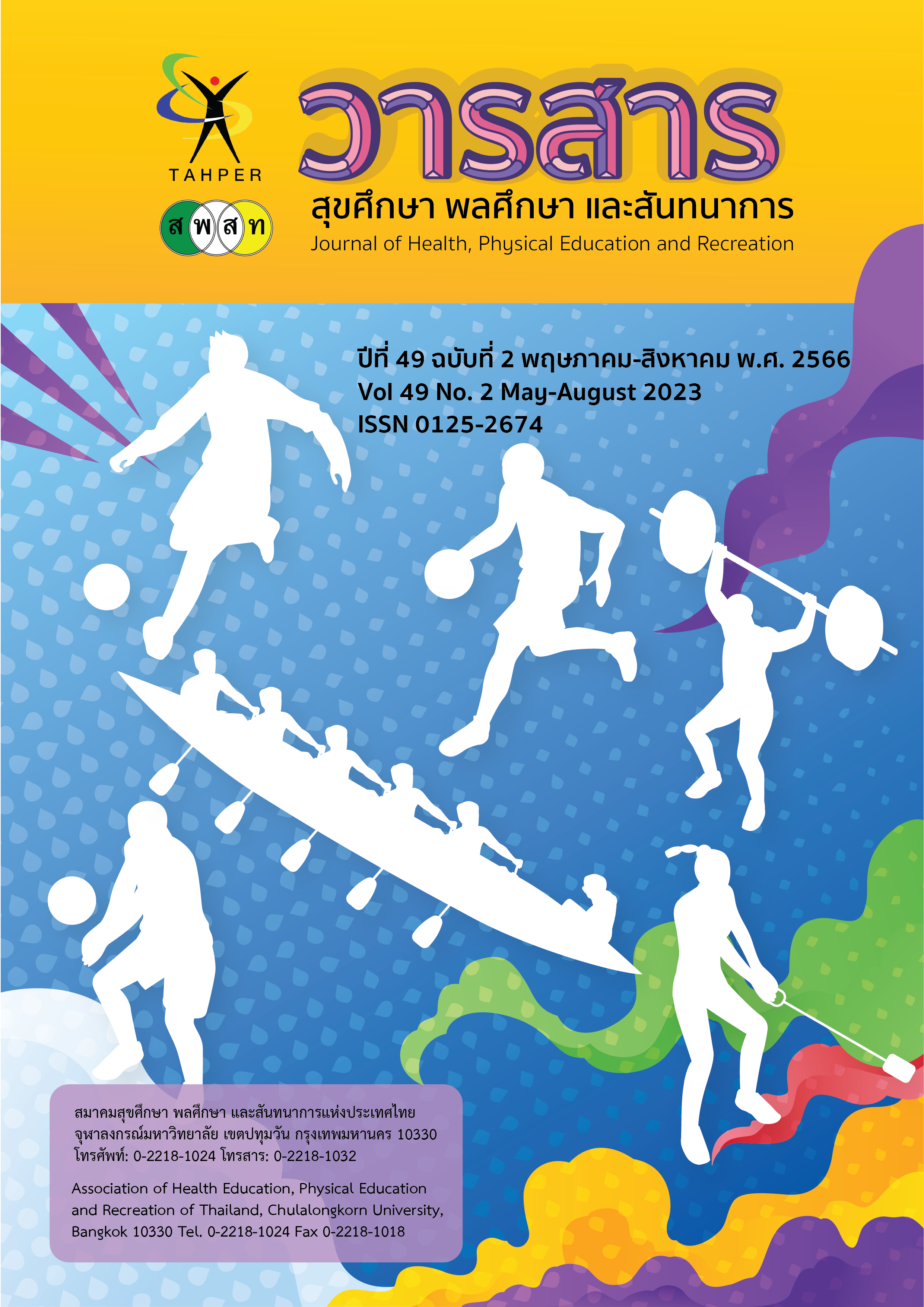Exercise Injuries caused by walking - running accumulating distance: the case study of KU-CSC Virtual run 2019
Main Article Content
Abstract
The objective of this research was to study injuries that arise from accumulated walking-running exercise. The research population was the number of participants who participated in the Cumulative Walk-Run Program (KU-CSC VIRTUAL RUN 2019) and 879 participants were sent to the cumulative distance walk-run. Using a ready-made table of Crazy and Morgan (Krejcie & Morgan, 1970,607-610), a sample of 269 people. The researcher sent 879 online questionnaires via e-mail and received 292 questionnaires, The researcher then analyzed the data by using 292 questionnaires. The tool used for data collection was a questionnaire developed by the researcher. Analyze the data by distributing the frequency. Percentage and standard deviation
According to the research result. It found that of the external organs that were most injured was the shoulder range, 7.50 percent, followed by the lower back 7.10 percent, the position of the lower external organs most injured was the ankle 30.10 percent, followed by Calves 24.70 percent. The nature of the injury is Myositis, 22.90 percent, followed by Muscle cramps 13.40 percent, the level of injury with mild symptoms, able to walk-run the next day 40.4%, followed by severe symptoms that had to stop moving and unable to walk-run the following day, However, 8.2 percent did not need treatment. Currently, there are 84.2 percent of injuries and 14.4 percent have no injuries. The most external injuries are Inappropriate location and road surfaces, 52.70%, followed by unsuitable shoes / poor quality 46.60%, most of the injuries caused by walkers and runners by themselves were 46.90% of the posture of walking-running were followed by 40.8% of physical disabilities, 52.1% of them were mentally ill and 33.2% of them were stressed. Walkers-runners
have first aid after injuries during the 24 hours, most of them have a break at 57.90%, followed by no treatment at 31.20%, most of those who provide treatment are themselves 60.10% followed by friends at 24.00 percent, estimated duration of rehabilitation was less than 1 week 81.80 percent, 1-2 weeks 1-2.80 percent and more than 4 weeks 1.70 percent
Article Details

This work is licensed under a Creative Commons Attribution-NonCommercial-NoDerivatives 4.0 International License.
Critical thinking in journals is the right of the author. The Association of Health Education, Physical Education and Recreation of Thailand is not always required, to create diversity in ideas and creativity.
ความคิด ข้อวิพากษ์ในวารสารเป้นสิทธิของผู้เขียน สมาคมสุขศึกษา พลศึกษา และสันทนาการแห่งประเทศไทยไม่จำเป็นต้องเห็นชอบด้วยเสมอไป เพื่อให้เกิดความหลากหลายในความคิดและความสร้างสรรค์
References
ชาญกิจ คำพวง. (2549).การบาดเจ็บของผู้นำเต้นแอโรบิกในเขตกรุงเทพมหานคร ปี พ.ศ. 2549. ปริญญาศึกษาศาสตรมหาบัณฑิต, บัณฑิตวิทยาลัย, มหาวิทยาลัยศรีนครินทรวิโรฒ.
ธีรวัฒน์ กุลทนันทน์. (2543). การปฐมพยาบาลเนื่องจากการบาดเจ็บจากการกีฬา. (พิมพ์ครั้งที่ 3). กรุงเทพฯ: โรงพิมพ์ไทยวัฒนาพานิช
ประวิทย์ หลักประเสริฐ และณรงค์ ศิริตระกูล. (2554).การออกกำลังกาย: การวิ่งสำหรับคนวัยทำงาน. วารสารมหาวิทยาลัยนราธิวาสราชนครินทร์, 3(2), 107-120.
พวงเพชร์ เหมือนสน. (2555). เอกสารประกอบการเรียน การป้องกันและการปฐมพยาบาล การบาดเจ็บทางการกีฬา. คณะวิทยาศาสตร์การกีฬาและสุขภาพ สถาบันการพลศึกษา วิทยาเขตสุพรรณบุรี.
สถานีโทรทัศน์ไทยทีวีสีช่อง 3 (2562). เทรนด์การออกกำลังกาย “มาแรง” ในปี 2018. สืบค้น 20 สิงหาคม 2562, จาก https://www.ch3thailand.com/news/scoop/10062.
สำนักงานกองทุนสนับสนุนการสร้างเสริมสุขภาพ. (2560). การวิ่งดีมีประโยชน์ วิ่งอย่างไรไม่ทำร้ายสุขภาพ. สืบค้น 20 สิงหาคม 2562, จาก https://www.thaihealth.or.th/Content/39497-การวิ่งดีมีประโยชน์%20วิ่งอย่างไรไม่ทำร้ายสุขภาพ.html.
วิภาวี ลักษณากร รัตนา วิเชียรศิริ และนลินทิพย์ ตำนานทอง. (2551). ความชุกและปัจจัยที่มีผลต่อการบาดเจ็บของนักวิ่งเพื่อสุขภาพในอำเภอเมืองจังหวัดขอนแก่น. วารสารเวชศาสตร์ฟื้นฟู, 18(2), 42-46.
อรนภา ทัศนัยนา. (2561). เอกสารประกอบการสอนรายวิชาวิทยาศาสตร์การกีฬาเพื่อสุขภาพ.มหาวิทยาลัยเกษตรศาสตร์วิทยาเขตเฉลิมพระเกียรติจังหวัดสกลนคร.
อรรถพล มงคลภัทรสุข คมศักด์ สินสุรินทร์ ภิญญาดา วารัตนกสมี พรรณนากร สุงนาค และเลอลักษณ์ สุทธิวิริยกุล. (2561). ปัจจัยที่มีความสัมพันธ์ต่อการบาดเจ็บรยางค์ขาในนักวิ่งมาราธอน การศึกษาเชิงสำรวจในกรุงเทพฯ มาราธอน 2013. วารสารวิทยาศาสตร์และเทคโนโลยีการกีฬา, 18(2), 73-80.
Krejcie, R. V. & Morgan, D. W. (1970). Determining Sample Size for Research Activities. Educational and Psychological Measurement, 30(3), pp. 607-610.


